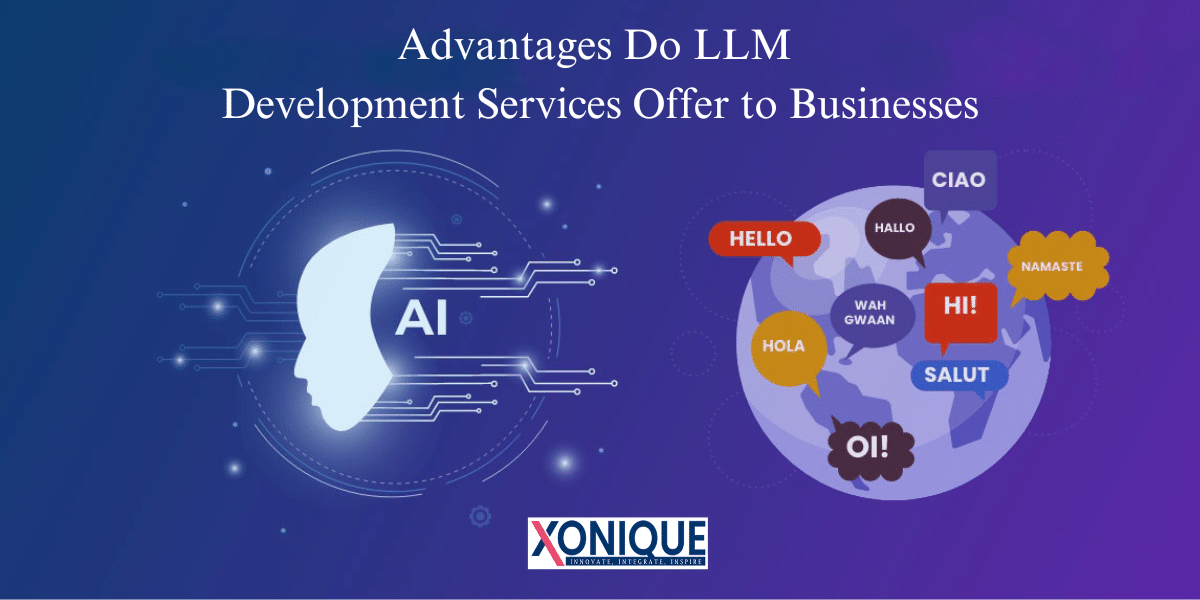Large language models are becoming a vital resource for companies, allowing them to develop and keep in step with their competitors. In addition, the advancement of artificial intelligence affects businesses at every level. It’s hard to stay from this technological advancement, which is fast becoming necessary in the business world. Large Language Model Development is evolving to be powerful tools that can boost communication, automatize complicated tasks, and increase operational efficiency.
Large-language models are sophisticated artificial intelligence (AI) models based on massive amounts of text data that are created to recognize and produce text that resembles human language with large-scale natural processing (NLP) techniques such as Generative pre-trained Transformers (GPTs). LLMs are now a significant element of the AI scene because of their capacity to transform various business processes and ChatGPT being the leader in transforming the technology environment.
Although pre-trained models are readily accessible, many companies are starting to see the advantages of creating their own custom LLM. To understand how groundbreaking an LLM benefits your company, continue reading this blog till the end.
What Exactly Is LLM (Large model of language)?
A LLM is a machine-learning model developed using massive data to understand and create human-like languages. The models are typically constructed with deep learning methods like neural networks. They can interpret and process texts in a manner that is similar to human intelligence. The LLM can accomplish extraordinary accomplishments like producing precise and pertinent responses in a text summary, translating between two languages, and writing complicated reports or articles.
Advantages Of Using LLM Development Services For Your Business
Utilizing LLM Development Services offers numerous advantages and benefits across a variety of domains, such as:
Streamlined Customer Interactions And Services
One significant benefit of integrating big AI models into the enterprise is dramatically improving customer experience and service. Advanced machine learning models can provide customized and precise responses to customers’ questions, greatly enhancing the user experience.
In today’s highly competitive marketplace, customer happiness and loyalty depend on the speed and quality of service. In this regard, LLMs have a vital role in efficiently and quickly addressing customer inquiries and feedback and providing solutions specific to each customer’s needs. This leads to speedier resolution of customer problems and creates a feeling of trust and individualization in customer interaction.
In the case of customer support, for example, the LLM can analyze a client’s request and examine pertinent information in the enterprise’s system to provide an accurate and helpful answer. Its ability to offer rapid, precise, and targeted responses is a massive boost to the customer’s satisfaction. Additionally, these models can handle an enormous amount of customer interactions at once, ensuring that service to customers is flexible and effective.
Efficient Content Creation And Management
Another reason businesses need to incorporate large-scale modeling languages into their processes is their ability to speed up content production and administration. LLMs could change the way businesses approach creating content and managing it, making it more effective and in alignment with corporate goals.
Regarding social media marketing and content administration, LLMs can automate and simplify the production of various forms of content, from blog articles to social media posts. Utilizing machine learning and training data models These AI tools can create appealing, quality material that represents the brand’s voice and is in tune with the intended audience. In this case, for instance, the LLM can be re-fed with specific themes, brand guidelines, and demographics of the target audience for a set of blog content or posts on social media that are informative and engaging to users.
Additionally, LLMs contribute to content administration by helping to categorize, tag, and manage vast amounts of information. Companies possessing large quantities of digital content will find this feature particularly advantageous. AI can analyze and categorize content according to its relevance to themes, performance, and indicators, assisting in the efficient curation and reuse of content. It helps save time and ensures that an enterprise’s content is relevant, fresh, and aligned with modern marketing practices.
LLMs are also essential in personalizing content and creating content tailored to specific segments of customers or preferences. This degree of customization increases customer satisfaction and enhances campaigns’ results. LLMs’ capacity to adjust content according to the latest data and feedback will ensure that marketing strategies constantly evolve and adapt to changing market trends and consumer preferences.
The effect of this in boosting customer loyalty is substantial. When clients receive timely and precise support, their confidence in the company grows, increasing customer loyalty and potential business opportunities. Utilizing LLMs to improve customer interaction and service, businesses can ensure an exceptional customer experience and stand ahead in this highly competitive market.
Marketing And Advertising
LLMs can produce personalized marketing materials like email campaigns or social media updates. Businesses can use this to connect with their clients more efficiently and effectively. For instance, the LLM can create a customized email for clients who recently abandoned their carts. This email could contain details about the items customers are looking for, along with discounts and offers.
LLMs can be utilized to develop chatbots that engage with customers naturally. Businesses can use this to provide customer support 24/7 without hiring extra personnel. In this case, for instance, the LLM can be utilized to build a chatbot to answer customers’ questions regarding the products, services, and shipping. LLMs can create marketing materials, such as blogs, articles, and posts on social media. The content draws interest and engages customers to promote the products or services. In the example above, the LLM can generate a blog post regarding a product’s release or develop an online campaign on social media that encourages users to share their experiences using the product.
LLMs are a great way to make ads more targeted to specific groups of people. They can assist businesses in connecting with their clients more efficiently and effectively. In particular, the LLM can be utilized to target ads at those interested in similar goods or services. LLMs may be used to assess the effectiveness of marketing efforts by studying customer data and social media activity. The data can be utilized to enhance future marketing campaigns.
It can produce a range of different texts, including scripts, poems, code or musical compositions, emails, and letters. It can also be used to produce engaging and personalised marketing material.
Advancing Business Innovation And Agility
Furthermore, businesses that use large-language models can boost firms to innovate and be agile. LLMs do not just make processes more efficient; they can also provide new opportunities to solve problems with creativity and strategic growth.
LLMs promote a culture of innovating within businesses by offering different ways to analyze data. They can provide new insights that could inspire new products or marketing strategies, as well as strategies for engaging customers. For example, An LLM will analyze trends and patterns of consumer behavior using different data sources, which allows firms to spot market trends and change their strategies accordingly.
Furthermore, the versatility and flexibility of big language models allow businesses to respond swiftly to market changes. In a world where business agility is the key to success, swiftly adapting strategies to AI’s insights is a significant benefit. LLMs help with this by constantly collecting relevant information and providing valuable intelligence.
Additionally, LLMs can be instrumental in the development of new business strategies. Through their innovative AI capabilities, businesses can explore new options and concepts, eventually leading to new solutions that alter the standards of market practice. This is one of the reasons why LLMs can be particularly useful for businesses experiencing digital transformation: they can keep up with developments in the field of technology and the market.
Moderation Of Content
Large-scale language models are vital to automatic content moderation as they filter and identify user-generated content across different platforms. They can identify issues such as insulting words, hate speech threats, fake news spam, and other inappropriate or unwelcome content and provide a secure internet environment for users.
Based on your chosen approach, the system can flag offensive material for further investigation or remove it from the site according to predefined moderation rules. It is essential to remember that although big language models may be valuable tools for automated content moderating, human oversight remains critical, especially in handling complex cases.
Employers Can Lower The Operational Cost
The ability to retrieve information accurately is just one of many benefits that have placed LLMs at the forefront of businesses. Your staff processes many transactional, financial, and operational information daily. This can drain productivity and also eat up your company’s time. Big language models can cut operational costs by 30 percent by automating tedious job tasks.
However, to gain this advantage, the model must be refined using the company’s internal data and then connected with operational data. This establishes the background for LLMs and enables employees to quickly access relevant data through natural languages.
Making Better Decisions And Identifying New Opportunities
Language models can quickly analyze and interpret vast quantities of internal and third-party information, such as reports, news stories, and customer feedback, to discover patterns and patterns. Armed with an overview of data, organizations can eliminate the uncertainty from their plans and make an informed decision, whether developing a brand new product or an innovative market segmentation.
Furthermore, models with fine-tuning allow you to dig into past company data to predict and assess the risk associated with a new venture. Companies can use the information for immediate responses or ask questions in the future via language prompts.
Long-Term Budget Control
It’s not a good idea to ignore the facts. Establishing an LLM involves substantial initial investment, which could be very profitable in the long run. The models for foreign languages are usually based on the cost per subscriber or per transaction. Depending on this, these expenses can begin to add up when technology utilization increases. A model that you own gives you control of these expenses.
Enhanced Data Accessibility And Interpretation
Companies often turn to LLMs for enterprise LLM because of their ability to make large quantities of enterprise data more usable and understandable by all departments in an organization. LLMs, due to their superior capabilities in natural language processing, allow for more diversified access to data within an organization. This capability starkly contrasts traditional approaches, which had access to data limited to IT departments and experts in data.
LLMs provide a more inclusive method of handling data, allowing employees with various backgrounds and jobs to collaborate with and draw valuable insights from the data in their enterprise through simple natural languages. The democratization of access to data is crucial to breaking down the silos of information and making it easier to collaborate and inform decision-making throughout the enterprise.
Automating Grunt Work Tasks And Boosting Efficiency
Routine, repetitive business tasks can be another area of specialization that language models can help with. Based on data from the business, the models of smartness can perform the heavy lifting for routine tasks while freeing space for more excellent strategic making. Transferring tasks such as creating content, providing customer support, or even data entry AI also aids companies in cutting labor costs.
Preparing For Custom LLM Development
In the process of preparing for the creation of a customized LLM, There are a number of important steps to consider. This includes identifying the available sources of data, preprocessing and cleansing the data. Also performing feature selection, and engineering in order to maximize the performance of the LLM development model’s capabilities.
We’ll look at these steps thoroughly:
Identifying Available Data Sources
To develop a custom LLM, you must determine pertinent data sources that can be used in creating the model. These could be internal documents, interactions with customers, publicly accessible data, or any other text-based data relevant to your particular business. A diverse and complete data set is essential for ensuring that your LLM knows the specifics and contexts of your field or industry.
Data Preprocessing And Cleaning
When you’ve acquired the data, processing, and cleansing are required to ensure it is ready for training for the LLM. This includes removing unimportant or noisy information, standardizing the formatting of texts, addressing the absence of values, and ensuring the data is consistent. The data is cleaned up to create solid foundations that allow the LLM to draw lessons that will improve its efficiency and precision.
Feature Selection And Engineering
The feature selection and engineering process involves determining which information elements are most relevant to the LLM and then implementing or creating appropriate aspects. This process helps highlight specific information elements that the LLM must pay close attention to and ultimately improves its capacity to read and write texts. It is essential to select features that match your company’s goals and usage case.
What’s Hindering Enterprises From Taking Advantage Of LLM Development
In the AI area, language models come with the same risks that were always present in intelligent applications.
Data Privacy And Security
Businesses often deal with sensitive customer data, so ensuring data privacy is essential. If using products powered by LLM, enterprises must implement secure access and encryption of data. Also comply with data security rules, and continually review and monitor the data handling process.
Ethical Concerns
LLMs are prone to perpetuating the biases present in their training data. Businesses should be aware of the ethical issues and strive to minimize the effects of bias. It can be done by examining the data used in training for bias using fairness-aware algorithms, regularly auditing, and evaluating AI-generated material.
Domain Expertise
The LLM is highly adaptable; however, it might not have the specific expertise required for a particular field. Companies in specific industries, including healthcare or finance, may want to consider using LLMs with specific knowledge of the domain or specialist systems training LLMs with industry-specific information.
Implementation Challenges Of LLM
Integrating LLM-powered devices into existing workflows or processes can be challenging. Enterprises must anticipate the complexity of integration to ensure compatibility with existing technologies, offer adequate staff education, and consider scalability issues.
Cost-Benefit Analysis
Although LLM integration could reduce costs, companies must conduct a comprehensive cost-benefit analysis that includes formulating the ROI (ROI) and estimating the ongoing expenses for operations.
Regulatory Compliance
Enterprises have to navigate a complicated regulatory environment regarding LLMs, specifically in restricted sectors. Maintaining awareness of language model regulations and ensuring that your LLM Development Company complies with industry rules and reporting obligations are crucial to business.
Best Practices For Implementing Large Language Models
Companies often need to take advantage of the latest AI models. These are the ways to get started.
Determine The Most Appropriate Application
Review your operations to identify areas where an LLM could benefit, such as customer support, content creation, and data analysis. Find tasks that you could delegate to LLMs.
Choose The Suitable Model
Pick the right LLM depending on your business’s needs, taking into account the complexity of your task, capabilities in modeling, and resource requirements.
Make Sure You Have The Information In Order
Collect and process relevant information to tweak the selected model to align with your specific business needs and provide accurate, relevant outputs.
Design The Integration Of Existing Systems
Implement the integration of an LLM into your technological infrastructure and business processes for seamless operation with little interruption.
Assess And Monitor The Performance
Always monitor the efficiency of the LLM, using measures like accuracy, response time, and user satisfaction to pinpoint areas for improvement.
Consider Privacy And Ethical Considerations
Be aware of possible issues with privacy and ethics related to AI deployment. Adhere to data protection regulations and use AI technologies responsibly.
Be Aware Of Scalability And Upkeep
Make plans for maintaining and eventually growing your LLM implementation. Consider data storage, computing resources, and periodic model updates.
Develop A Culture Of AI adoption
Develop a company-wide understanding and appreciation for AI technology by offering training and tools for employees to use and embrace LLMs.
In Summary
Due to their vast dimension and deep-learning capabilities, Large Language Model Solutions provide a revolutionary technological leap toward artificial intelligence. They originate in the development of language models, which dates back to the beginning of AI research. They form the basis of NLP applications, revolutionizing how we communicate and create content.
Although LLMs specialize in language-related tasks, they now expand into multimodal domains by creating and processing content using texts, images, and codes. Their versatility has resulted in widespread acceptance across many industries, including coding support for content generation or translation and sentiment analysis. This adoption rate is anticipated to rise with the advent of more special LLMs, advanced multimodal capabilities, and the advancement of this area.
They are already showing the significant benefits of using enterprise software across various applications and functions; LLMs are not without issues, such as biases in training data, ethical questions, and complex interpretation issues. Enterprises must carefully analyze these models according to their particular use cases, considering factors like the speed of inference, model size, fine-tuning, and costs when they do and will be able to tap into the tremendous potential of LLMs to boost productivity and innovation across the AI environment, changing our interactions with technology and data.











